Jonathan Hoffman

How did you get started as a maquette sculptor?
I’ve been working with oil-based clay since I was around seven or eight years old. At the time, my sister was into claymation, and she created some wonderful short stop-motion films using an old camera that allowed her to snap one frame at a time. She let me play with some of her clay until I eventually got my own.
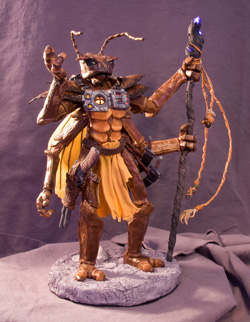
At the time it was a major source of entertainment—I’d make armies of intricately detailed starships and I’d enact epic battles that left much of my fleet as clay wreckage, while the surviving ships would have scars carved across their hulls. I made and kept up these sculptures for years, as well as a variety of other creations I used as a physical representations of a story that I would play out in my mind. Eventually I started making larger, human figures in the clay, first as reference for lighting for my drawings, but eventually simply for their own sake.
When I was about thirteen, I was introduced to polymer clay, a clay that behaved much like my modeling clay but that could be hardened in a regular oven. It was a very natural progression from sculptures in oil-based modeling clay to working in polymer clay; however, learning the ins and outs of the craft was a major trial by fire. Most of my early attempts at figures were disastrous, falling over or falling apart during the curing process. It wasn’t until I was out of high school that I had figured out how to incorporate an armature into the base of the sculpture to ensure the clay would hold up when it was cured. Almost all of my methods and procedures have been self-taught, by simple trial and error.
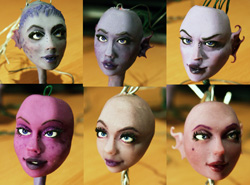
Since that time, I have expanded that simple formula and gotten more sophisticated in my techniques and understanding of the human figure. Studying illustration and then animation at BYU helped me also to understand character design and composition. Sculpting my figures has not ever been for any particular academic or financial purpose, though I did create a few commissioned pieces while I was attending BYU, and much of my work was displayed for a time in the BYU bookstore. Most of my work originates simply with the fact that I enjoy creating characters and fully rendering them in three dimensions. That remains true today—I sell a few and a few are commissioned, but mostly I sculpt for my own interests.
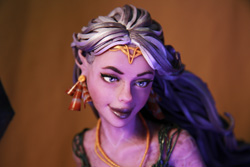
Walk us through the process of translating a two-dimensional painting to a 3D maquette, like you did with Zak the Fly Hunter.
Most of my ideas start in two dimensions, as a simple doodle done during sacrament meeting or an idea that pops into my head at work. Zak the Fly Hunter was actually first visualized during Sunday School, I believe, as a doodle on a sheet of printer paper folded in half.
Whether the design has been fully realized as a painting or not, I’ll measure its proportions before I create a wire armature using the appropriate ratios of length of head to legs to body. In the case of Zak and any of the other sculptures that involve electronics, any wired components must go in and become part of the armature. Typically my brother, James Hoffman, also a BYU alumnus who studied both computer programming and electrical engineering, creates the electronic components of my sculptures. In this case however, I did my own soldering and wiring for the lights, building them into the wire skeleton armature.
After the electronics are in place, I build the clay in layers on top of the wire, adding specialized parts like the eyes, which are made with a combination of clear epoxy resin and polymer clay. The process of using colored clay is rather unforgiving, as whole sections of the sculpture have to be removed if I decide that I must change a particular part or correct an error that has occurred. I’ll cure the sculpture several times in the process of creation, layering on detail as I go.
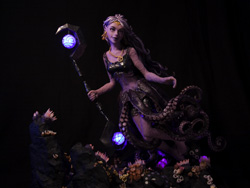
What similar processes do you follow when you paint?
Once I have the sketch idea, I’ll refine the drawing and the composition for a time before moving on to color. I’ll scan the image and then paint it digitally (as this is much cleaner and quicker than working with real media) to work out color texture and material quality for the piece. There’s a lot of mucking about as I paint directly on top of the scanned sketch, fiddling with lighting color and image detail, though I’ve tried to become looser in my style in recent years.
How does your work in those two mediums interact? Which medium do you prefer? Why?
Most of the time my paintings are simply one step in the process of creating a character sculpture. I’m not terribly good at telling a story with my pictures, and very few of my paintings ever have more than one character on the canvas. More often they are simply a study in character, costume, and design, which informs my sculpting.
Painting for me is enjoyable on its own merits, but I find that I enjoy sculpture more. Many of my sculptures are created without having made a painting, remaining a pencil sketch—typically when I have a clearer image in my mind already and when colors are not as important.
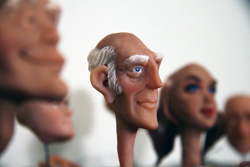
What are some of your favorite projects you’ve worked on?
I’d say my favorite project to work on was the Zik’istri sculpture (the big cockroach-looking fellow), as the creation process went rather smoothly and I created that sculpture entirely at my brother’s apartment. Working there was enjoyable because I was right next door to his office where we could interact and share ideas of how we would integrate his electronic components into the sculpture and how he would animate the lights to create a particular effect. The sculpture turned out well and had very few problems, and it was really a process of discovery as we were both new at using LEDs in my sculptures.
I’ve enjoyed collaborating on quite a few sculptures since, but others have had some frustrating times where technical problems slowed the process or catastrophe has set us back for months.
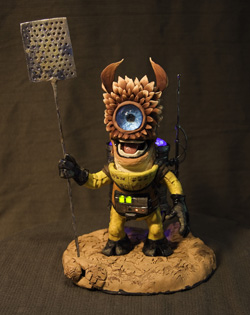
Tell us about working for Pixar.
I’ve always wanted to work for Pixar, and I was fortunate enough to get into the animation program at BYU.
The BYU program is excellent, and it allowed me to work on many group projects and to build a portfolio that interested Pixar recruiters. I applied for an internship at Pixar, and on my second attempt was accepted.
I do shading and texturing for Pixar, which uses both my technical knowledge as well as my artistic abilities. I’m essentially a detail fanatic, so shading is a perfect place for me.
What do you consider your greatest achievements in your career so far?
Getting hired at Pixar is by itself a great honor for me. I never considered it possible and still feel very lucky and privileged to have been given the chance.
Working on Up was similarly a fantastic opportunity, and having the chance to take notes from Pete Docter and work with the amazing and talented people on that film is something I’ll always remember—my first time being in the credits of a Pixar film.

You work a lot in fantasy. What draws you to that genre?
Fantasy, to me, is a genre that has the most potential for creative expression. I love to create entirely new cultures and worlds and environments in my fiction, and the stories that I create are typically the basis for my sculptures and paintings, though on occasion the reverse has been true: a sculpture idea or a painted image has spawned the stories that give it context.
Fantasy lets you do whatever you want, whether it be futuristic or primitive or any interesting juxtaposition of the two—so visually, it allows me to have the most flexibility in design.
Technically, I consider most of my work science fiction, simply because the term “fantasy” conjures up images of elves, dwarves, dragons, and battle-axes, which are quite definitely not included in my stories. My story has elements that are similar to fantasy, but it takes a more technical, logical approach to its system of supernatural events (its so-called “magic” is more like science)—and there are space ships. Space ships generally mean science fiction. I like cross-pollinating the genres as much as I can, stealing interesting ideas from both.
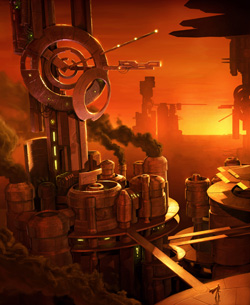
You mention working on a novel in many of your blog posts, and many of your paintings and sculptures also seem to be of characters from that story. Tell us more about the novel.
It’s a dangerous thing to ask me about my novel because if you do you’ll likely get a longer explanation than you’d prefer.
The working title of the book is Prometheus’ Fire, referring to the Greek myth in which Prometheus gives the divine power of fire to man, resulting in man’s great ability to both create and destroy. This idea is a central theme throughout the book, played out as a powerful race of ancient creatures unlocks in mankind their latent abilities, a single event that dramatically shapes the course of human history.
The story primarily follows a pair of siblings who are drawn into a desperate hunt across their known galaxy, both of them being pulled by opposite sides of a conflict that originated thousands of years before they were born. And that’s the tag line I’d put on the jacket cover if it ever gets published.
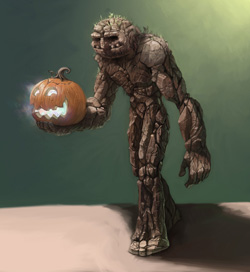
The actual manuscript itself took four years, but many elements had been kicking around in my head since high-school. It is primarily science fiction, though it probably fits most neatly into the sub-genre of “space opera,” which essentially means that it doesn’t focus so much on technology or some cerebral concept about the future—merely that it’s set in an environment in which technology has advanced beyond what we have now.
The story was a pretty monumental effort for a full-time student and then full-time employee of Pixar. It’s over 300,000 words long (which is a typical length for this genre), though the book was intended as the first in a series of three or four books. The story holds up decently well, though I’ve been considering revisiting it and hacking away some of the fluff now that it’s been on the shelf for about a year, as well as leveraging a couple of ideas that I’d really only touched on lightly in the original manuscript.
I have started two other story ideas since I set down Prometheus’ Fire, both single-book stories that have no associations with my first book. Anyone interested in reading them need only contact me and I’ll send over a copy.
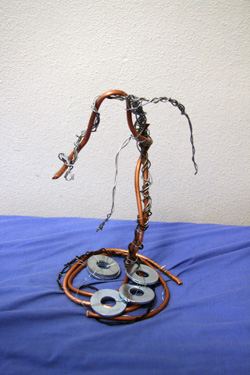
How do you think your Mormonism affects your art?
You know, beyond not making my characters extraordinarily immodest, I’d say my convictions to my faith and my art are pretty separate. I have occasionally made religious pieces, such as when I made some Book of Mormon sculptures for the BYU bookstore, but beyond that, the influence of my faith is more subtle.
I personally don’t find very allegorical works appealing (e.g., The Lion, the Witch and the Wardrobe); I prefer a more round-about allegory like The Lord of the Rings, in which Christian themes are explored without a direct one-to-one relationship with a scriptural account. I believe a story worth telling talks about human experience in a way that is edifying, where you learn something about life and the consequences of our actions and the potential man has for great good or great evil. Obviously big themes like this aren’t going to appear in my character sculptures, but they exist in the stories behind the pieces. I believe fantasy has great potential for telling stories in a way that is removed from our current situation, and hence more objective in its approach to problems and situations in which we find ourselves in the real world.
Tell us more about the Book of Mormon sculptures you did for the bookstore.
During my junior year at BYU, I brought one of my sculptures to the BYU bookstore and showed my work to Val Ugolini. The sculpture was of Captain Moroni with the title of liberty, which I found to be a very dramatic piece and probably the most successful religious sculpture I have done. I asked Val if he would be interested in displaying my work in the lower gallery of the bookstore, He was pleased with my work, and I produced a series of Book of Mormon sculptures to go along with the Moroni sculpt.
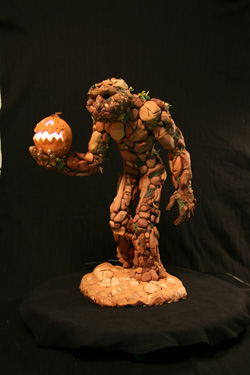
I then produced sculptures of Enos, Abinadi, Nephi, and Mormon—all of which were displayed for about half a year in the store. During Education Week I sold the Moroni sculpt and was commissioned to do another series of sculptures for a family. The Nephi sculpt sold a couple years later at a festival, and the remaining three pieces were given away to friends and family members. So, I actually have none left in my possession.
Sculpting work from the Book of Mormon was actually a little frustrating, in that if my work didn’t look very similar to Arnold Friberg’s interpretation of the scriptural figures, people had a hard time accepting them.
One woman, upon seeing my sculpture of Nephi told me, “That’s very nice. But that’s not what Nephi looks like.” I refrained from asking her how she could be so sure without having seen his photograph.
Nevertheless, it was enjoyable making the sculptures, blending my own impressions of these great men with some of the elements of iconoclastic Mormon images so that they would at least be recognizable as the figures they represent.
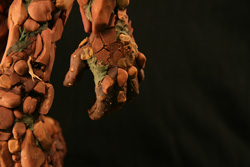
What are you working on now?
At present I am working on the designs of several sculpt ideas, and I’m not sure which one will be produced first. I have one idea painted on my blog (the “Kaisa” design) which I’ll get to eventually, but I’m going to wait because her sculpture will require some intense electronics.
My last several pieces have been intense on the electronics side (Terec, Zak, and Elrae), so I’m going to take a break and do some LED-free sculptures. ❧
